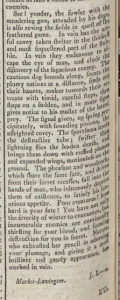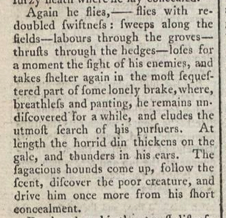
LM X (Oct. 1779). Image © Adam Matthew Digital / Birmingham Central Library. Not to be reproduced without permission
A frequent contributor to the Lady’s Magazine in the 1770s and 1780s bore the signature J. L-g from Market Lavington, a small town in Wiltshire. Some of the items provided by the writer, such as ‘A Caution to the Ladies’ in the 1778 supplement, are opinion pieces designed to advise women against the dangers of fortune tellers, female vanity, and indolence. But other works were meditations and reflections penned whilst walking through the town’s surrounding fields and forests. Describing the prospects, flora, and fauna, the works focus on the emotional and spiritual states the writer experiences in nature.
It was whilst reading the October 1779 contribution entitled ‘A Description of October’ that I began to develop that sympathy and liking for the subject that can so quickly send an archivist on a wild and time-consuming chase to identify the person behind the mysterious signature. This reflective work revealed more of the author’s personality, demonstrating his love of animals and environment and an empathy with the hares and pheasants pursued by hound and hunters.

LM X (Oct. 1779). Image © Adam Matthew Digital / Birmingham Central Library. Not to be reproduced without permission.
J. L-g describes the hare, ‘poor timid creature’, that ‘perplexed, and in the utmost distress […] pours all his soul in flight’ (Oct: 542) before he ‘falls a victim to his numerous enemies’. The writer then turns to the ‘murdering gun’ of the fowler and the pheasants who are killed for the ‘luxurious appetite of man’, lamenting: ‘poor creatures! How hard is your fate!’ (542).
In spite of his conservative advice (that, frankly, rankled me at times), J. L-g identified so deeply with the persecuted prey that I reluctantly began to like the author who hitherto seemed cantankerous and moralizing. Feeling a peculiar kinship to a long-deceased writer is not such a bad thing for archivists working with so much anonymous and pseudonymous literature. It is easy when reading so many items by the same person to develop an idea of who they were and what they were like, to create a name to fill the blanks in the signature, and to imagine the person behind the persona. Though my research role on the project is to focus on the magazine’s content, it was this sense of kinship, that sneaking fondness for the self-described shy and reclusive writer, that made me so interested in the man behind the contributions.

LM X (Oct. 1779). Image © Adam Matthew Digital / Birmingham Central Library. Not to be reproduced without permission.
When other items from the same town began appearing signed ‘E. L-g’ or ‘Eliza L-g’ or ‘E-h L-g’ I began to feel I had at least a few possibilities to send on to the project’s attribution research associate, Koenraad Claes. But Koenraad’s research skills would have been wasted on this because in one quick google search for the keywords ‘18th century’, ‘Elizabeth L’ and ‘market lavington’ I was directed to the Market Lavington Museum blog that made it clear the signatures belong to John Legg and Elizabeth Legg, siblings, of Market Lavington. A quick email to the very helpful museum curator, Rog Frost, supplied me with a memoir of John Legg and photographs of the gravestones. These can be viewed on the museum’s blog.
Identifying John and Elizabeth Legg is only one small piece of a much larger puzzle of contributors and communities of writers. But it helps us to ask more questions about the correspondents and their relationships with each other and the editors of the Lady’s Magazine. It also demonstrates how essential modern day communities of researchers, curators, genealogists and bloggers are in uncovering the men and women who wrote for the periodical.
Dr Jenny DiPlacidi
School of English
University of Kent
